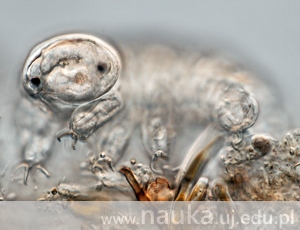
Studying microscopic organisms called tardigrades, colloquially known as water bears or moss piglets, has secured the Diamond Grant for Piotr Gąsiorek, a student of the JU Faculty of Biology and Earth Sciences.
Diamond Grant is a prestigious award for extraordinarily talented students who plan on pursuing an academic career. Every year, about one hundred students from all of Poland are awarded with the Grant. In this year’s edition, it was presented to Piotr Gąsiorek, an MA student from the JU Faculty of Biology and Earth Sciences.
The young researcher is interested all branches of classical zoology, from morphology and geography to taxonomy and evolution. He’s fascinated by issues related to evolutionary biology, such as speciation. Within the framework of his current research, he’s working on the phylogenesis of a rare subfamily of water bears, as well as describes new genera and species.

Tardigrades (Tardigrada) are small invertebrates measuring between 0.01 to 1.2 millimetres. They are classified as protostomes and inhabit mostly humid environments. Their most distinctive characteristic is the fact that they can enter the state of cryptobiosis, i.e. hibernation caused by unfavourable environmental conditions. Due to their appearance, they have been nicknamed ‘water bears’ and ‘moss piglets’.
Wallace Line: a key to Diamond Grant
The project that gave Piotr Gąsiorek his Diamond Grant is entitled Testing Wallace – models of diversity and distribution of microscopic invertebrates: Tardigrada – a case study. It aims to verify the theory of a famous biologist, Alfred Wallace, who in 1859 proposed a boundary line separating the Oriental and Australian ecozones. In his work, the young JU researcher wants to employ molecular techniques, scanning electron microscope imaging, and analytical zoogeography. He hopes to discover if the Wallace Line, running across Southeast Asia and Australia, is accurate when it comes to division of microinvertebrates.

Due to a unique geological history of the region, Wallacean fauna is characterised by a high level of endemism (which means that the animals found there live nowhere else in the world). There are as many as five unique biotas in Wallacea (Java, Borneo, Celebes, Moluki, and New Guinea). ‘I will find out if tardigrades are just as exceptional as the rest of the animals’, said Piotr Gąsiorek.
New perspectives
Piotr Gąsiorek’s research may well prove that the geographical distribution of tardigrades is different from that of macroscopic animals such as vertebrates. The Grant will provide him with the funds necessary to study the water bears of Sunda Islands, which are still largely unknown to us. He will probably have the opportunity add many new species to the list of known tardigrades.
The biologists said he will travel to Sunda Island a second time in the near future to collect moss, lichen, plant litter, and soil. It will undoubtedly be both an extraordinary experience and hard work. In the tropical climate, it is particularly important to prevent the collected materials from rotting or moulding. Well-preserved samples can be moistened and researched even after a few years, making them a perfect source of invaluable information about the creatures’ DNA.
Photograph below the title: Frank Fox. Licence: CC BY-SA via Wikimedia Commons.
Original text: www.nauka.uj.edu.pl





